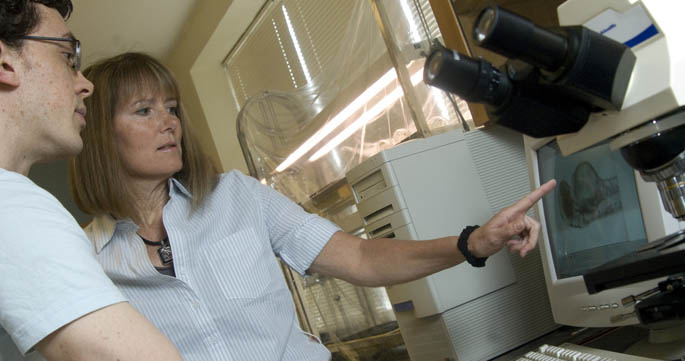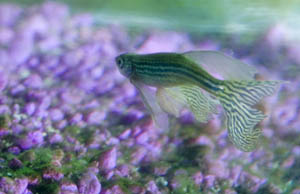Research project explores the depths of developmental biology
Research on zebrafish and plants may aid fight against cancer and other diseases

Above: Associate Professor Diane Krill and laboratory technician John Madden work with a fluorescent inverted microscope in the biology lab in Academic Hall. Below: A zebrafish.
The Point, Fall 2010
While Point Park may not come to mind when thinking of research universities, research is being conducted here that could have implications in fighting cancer and heart disease.
"It could have agricultural as well as potential medicinal impact," says Diane Krill, Ph.D., associate professor of biology, speaking in general terms about her current research with zebrafish and plants. The developmental molecular biologist will speak more specifically about her research over the past year and a half when it is published, most likely this fall.
Related links |
Dr. Krill has been working with students in her developmental biology and molecular biology lab classes to conduct the research. Zebrafish are ideal to study heart development as well as angiogenesis, the development of blood vessels, because zebrafish eggs are transparent. "While they are developing, you can watch the heart start to beat, the fluid start to circulate in the vessels," explains Krill. She says trying to develop compounds that may interrupt the development of blood vessels could be beneficial, for example, in the treatment for a tumor.
Zebrafish are also popular for research because these simple vertebrates have similarities with humans, according to Krill. "There is a lot of homology between the human gene and the zebrafish gene that is expressed during the process of heart development." The fact that a zebrafish egg hatches quickly into a free-swimming form, within 72 hours, is another positive aspect. Krill and her students breed the fish, collect the eggs and track their development. They use different dyes to emphasize the blood vessels, and with the help of a fluorescent microscope, photograph the embryos in 3D and shoot live video to study the development, all without disturbing the natural process: at 24 hours, the beginning of eye, brain and heart development; at 48 hours, eye movement, beating heart, circulation; and at 72 hours, major organs and systems are formed.
While the zebrafish provide the lens to understand the development of the heart and blood vessels, Krill's plant research enables the purification of compounds, some of which can help in combating cancer, such as in tumor treatment. "I was interested in looking at the different chemicals that plants produce for potential medicinal benefits," says Krill of the plant research being done in her class. Krill and her students planted seeds and extracted from the plants a class of compounds called flavonoids. They then separated and purified the compounds by using high pressure, liquid chromatography. After that, they began their testing. On a research sabbatical during fall 2009, Krill went to Charleston, S.C., to use equipment at the Hollings Marine Laboratory to assist with the research.
 In contrast with the zebrafish development, the entire plant process takes up to six months, from seed planting, plant growth, and transplantation to extraction and purification of the compound. The compounds are formed in small quantities, so the time required for plant development provides a challenge, Krill says, to purifying a large enough quantity of a particular compound to determine its structure. "It's a fairly painstaking process; it takes time to go through all the steps to produce the purified substance." Krill and her students have been working to increase production by a thousandfold.
In contrast with the zebrafish development, the entire plant process takes up to six months, from seed planting, plant growth, and transplantation to extraction and purification of the compound. The compounds are formed in small quantities, so the time required for plant development provides a challenge, Krill says, to purifying a large enough quantity of a particular compound to determine its structure. "It's a fairly painstaking process; it takes time to go through all the steps to produce the purified substance." Krill and her students have been working to increase production by a thousandfold.
Students have been involved in different aspects of Krill's research since shortly after she arrived at Point Park in 2004: from graduate students who have analyzed results and improved methodology to work-study students and interns who have cared for the fish, planted seeds and taken measurements.
"I wanted a project that students could contribute to," comments Krill, and she is accomplishing that. Two students joined her in presenting research at a poster session at the American Association for Cancer Research's conference in Washington, D.C., in late 2008. Then-students Keli Caldwell (A&S 2007) and Shirley Charlton (A&S 2007) worked with Krill to present "A Screening Method for Identifying Potential Angiogenesis Inhibitors." In simplified terms, Krill and the students introduced a quick, inexpensive means for screening compounds to determine if they have anti-angiogenic properties, or properties to hinder the development of blood vessels.
Krill has been involved in various aspects of cancer research throughout her career as a developmental biologist. Is there any end in sight for her research? "Too many questions, too little time," she says. "Every single thing you find out leads to 10 more different questions." And each year, new students join in the quest for answers.
Article by Nancy Commella
Photo by Christopher Rolinson
This article originally appeared in the Fall 2010 issue of The Point, a magazine for alumni and friends of Point Park University.

